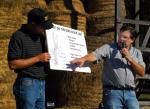PALMYRA, Mo. – When the news got out that a monster storm was bearing down on the East Coast, people in the hurricane’s path flocked to stores to stock up on supplies. Many who put off preparing for Hurricane Sandy faced empty shelves when they went out to buy batteries, nonperishable foods and other items.
Hurricanes don’t pose much of a threat to Missouri, but the Show-Me State does see floods, severe winter storms and, as residents of Joplin remember all too well, tornadoes. You can beat the rush and avoid a last-minute scramble by gathering most of your disaster supplies right now, before there’s even a hint of nasty weather in the forecast.
“The main thing is to get started,” said Sherry Nelson, University of Missouri Extension human development specialist.
“A couple reasons people might not prepare is that they feel overwhelmed by the process and that they can’t afford to do ‘all that stuff,’” Nelson said. “A better way to look at preparedness is to see it as a process that we do over time. And we continue to update it, such as by changing our weather radio and smoke alarm batteries twice a year.”
Households need three things to be prepared for weather emergencies: Emergency supplies, a weather radio and a disaster plan.
Emergency supplies
You might already have some of the basic items for an emergency supplies kit in your home, so you could make a good start on disaster preparations by locating those items—such as flashlights and batteries, a first-aid kit, and rain gear—and gathering them in one convenient location. If you have nonperishable, easily prepared food on hand, you might move some of it from the pantry shelves to your disaster kit. Remember to check the expiration dates on this food when you change batteries in your weather radio and smoke alarms.
If anyone in your household has specific medical needs such as daily medication for diabetes, heart conditions or high blood pressure, you’ll need to have those in your kit or as a “grab and go” item, Nelson said. “At least enough to get by for a few days. I have my stuff in a lunch cooler, so if we evacuate to the basement for a tornado, I just have to grab it and run downstairs.”
You can add to your emergency supplies a little at a time. “Break it down into manageable parts,” she said. “This also can make it more affordable—perhaps $20 per month, more or less.”
A free, downloadable guide to putting together a disaster supplies kit is available from MU Extension at www.extension.missouri.edu/EMW1012.
Weather radio
Just like smoke detectors, a weather radio should be a basic item of safety equipment in every home.
Weather radios are designed to receive information broadcast by the National Weather Service’s National Oceanic and Atmospheric Administration (NOAA). Many models can be programmed to sound an alarm when NOAA broadcasts emergency warnings for your area. They range in price from about $20 to $100 or so. Select a model with battery backup so that it will sound even if the power goes out. Test the radio regularly to make sure it will work when you need it.
NOAA has more information about choosing a weather radio that will work well for you on its website at www.nws.noaa.gov/nwr/nwrrcvr.htm.
Disaster plan
A disaster plan tells everyone in the family what they’re going to do when an emergency happens. A complete disaster plan will include information about each family member, household pets, insurance and finances, medications, vehicles, and the home and its contents.
You can download a disaster plan template at www.extension.missouri.edu/EMW1011. The PDF file can be filled out electronically, so you can update it frequently, easily print new copies and save backups on multiple devices and online in the cloud.
To keep your disaster preparations on track, Nelson suggests keeping to a schedule. The emergency management office of Washington County, Ore., produced a 12-month preparedness calendar that provides a checklist of items to buy and things to do for each month. It can be downloaded at www.ocem.org/pdf_resources/Prep_Calendar.pdf.
If you’d prefer to move at a quicker pace, American Red Cross chapters in Washington State have prepared a similar checklist spanning 24 weeks: www.co.thurston.wa.us/em/PA/24_WeekCalendar.pdf.
MU Extension has produced a number of publications and guides on disaster preparation and emergency management. Go to www.extension.missouri.edu/cemp and click on the “Publications” tab.
The Federal Emergency Management Agency also has online resources for families, businesses and communities at www.ready.gov.
Read more http://extension.missouri.edu/news/DisplayStory.aspx?N=1587





